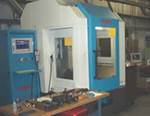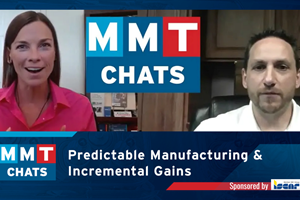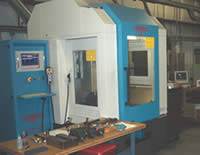M&M Tool and Mold, Inc.: Automation Investment Pays Off Big
Heavily relying on lights-out manufacturing coupled with a niche market in complex mold manufacture, this moldmaker lands its fourth accolade as a Leadtime Leader—three times as a winner and this year’s Leadtime Leader: Small Shop Honorable Mention.
In 12 short years, M&M Tool and Mold, Inc. (Green Bay, WI) has grown from a 750-square foot facility with two employees into a 13,000-square foot facility with 23 employees with a philosophy of “moderate, sustainable growth.” Company President Marty Ciriacks believes that heavily investing in automation combined with employees that embrace aggressive growth opportunities in a niche market of difficult-to-mold tools—those that require side actions, lifters, hot manifolds and production quality tools—in prototype time frames is responsible for the company’s remarkable sales growth of 22 percent over the past three years and sales of $4.9 million last year.
M&M Tool continues to specialize in intricate, single or multi-cavity, tight tolerance plastic injection molds in abbreviated leadtimes; multi-shot tooling; bridge and market entry tooling; and prototype tooling—usually produced in five weeks or less. Services provided include high-speed machining, electrode manufacturing, EDM and WEDM, full-service engineering, and part design and development. Industries served are medical (invasive surgery, disposable surgery, testing, etc.), automotive, consumer products (including hand tools, ATVs, personal watercraft, snowmobiles, motorcycles), agricultural equipment, and water treatment. Ciriacks points out that M&M diversifies to avoid any dips in certain sectors of the market, which allows the company to maintain a steady workflow and provide fairly stable hours.
In Business
M&M’s two owners—Ciriacks and Vice President/Secretary Mike Richard—have been moldmakers since the early to mid-80s. They started the business with a small personal loan from a small venture capitalist. They set up shop in a 750-square foot garage with an EDM, a mill and a grinder. Two months later, they moved to a 2,500 square-foot building and hired their first employee. The company’s current building was built in 1997, with employees added throughout the years. “We have seen our share of ups and downs within the trade, and have fortunately found a way to not get too high during the highs or too low during the lows,” Ciriacks notes. “We have tried to make solid business decisions throughout our careers to maintain our steady, sustainable growth. Every single machine purchase, growth plan, building expansion/addition, and personnel hire was intensely investigated, thought out, and implemented to the best of our ability. Decisions of this nature usually take a long time to rationalize and implement.”
A major part of this growth is the company’s major investment in lights-out manufacturing processes. “We feel that we need to remove the hands-on labor from the mold build in order to not only compete in today’s market, but to excel!” Ciriacks explains. “The capital investment is quite significant, but, if used correctly and effectively, has a reasonable return. This benefits
us in a second way—possibly an even more important way. It allows us to move more product through the shop, as effectively or better, than the conventional way of mold building. This creates more cash flow, the ability to stay current or ahead of creditors, and the most important side effect—quicker leadtimes with very, very few late deliveries! We continue to be there
for our customers, year after year, providing outstanding customer support and quality molds.”
Ciriacks adds that he and Richard would not be where they are today if not for M&M’s hard-working employees. “Our employees have a positive attitude and incredible work ethic,” he says. “Every day is an exciting new challenge. The opportunity to work for an aggressive company is very satisfying to them. This attitude translates into a healthy atmosphere that keeps the employees happy and motivated. Our turnover is very low, which leads to more friendships within the shop. This obviously turns into very high quality molds in abbreviated leadtimes that are done correctly the first time, which results in a healthy backlog and job security.” M&M also has an apprenticeship program, trying to have at least one apprentice active at all times. During its fifth year in business, the company went from eight to 13 employees to handle the workflow in the shop.
Holding Leadtimes
To maintain these stringent leadtimes, M&M works closely with the customer at the early stages of part design, design intent and mating part design to be sure to get the most functional part, always keeping cost and leadtime concerns at the forefront, according to Ciriacks. “We make it clear to our customers that a representative from M&M Tool is always available for a meeting anywhere, anytime,” Ciriacks emphasizes. The company also makes sure it is up-to-date with equipment and technology through trade magazines, trade shows, the Internet, and by talking with peers.
Another leadtime reducer is performing tasks that aren’t bound to each other concurrently, Ciriacks continues. “This shortens leadtimes over doing them after one another,” he states. “By having a skilled, diversified workforce, these tasks flow seamlessly into one another. We also manage the shop floor work flow very closely.”
Automation also plays a vital role in leadtime reduction. “We feel we have—by far—the most automation of any shop our size in the country,” Ciriacks asserts. “We are utilizing four System 3R robots to load and unload electrodes into and out of three high speed graphite machines and three EDM machines. We have been slowly phasing these in throughout the past five years, but the robot we installed earlier this year has proven to have the biggest impact so far. It is a three-machine cell—consisting of two high speed graphite machining centers (one standard left-hand version, and one custom right-hand version) with a 360-position System 3R carousel electrode magazine locate between them. The right-hand Okada has the ability to run a Nikken fourth axis in it, allowing us to lay electrodes down for side burning applications. This has made an unbelievable difference in our throughput!” Fortunately, the company is able to invest in this equipment because of a “solid forecast of work and a good relationship with your customer to assure there will be work for the machines,” Ciriacks adds.
M&M plans to further enhance this increased throughput with the purchase of a second Roeders high-speed, hard milling machine with a System 3R Dynafix robot to change out cavity and core inserts for hard milling and a new wire EDM—along with an “extensive plan to integrate Pro-Engineer into our entire manufacturing process.”
Adding On
M&M has aggressive growth plans for the near future. Currently, the company is in the middle of a 5,500-square foot expansion, which will house its steel prep area where all of the cores and cavities get prepared before heat treat. “We will be adding a new surface grinder for larger plates and inserts,” Ciriacks comments. “This expansion also will house a large engineering room with a bunch of computers for toolmakers to plan mold build strategies by laying out prints, monitor progress of work in process, and have numerous computer stations for uninterrupted access to design software. We hope to accomplish this with a proprietary software program we are designing with a custom software developer. We want to make it live and interactive with everyone in the shop so they can immediately see where a job stands. We’d also like our customers to be able to access this information with a user name and password that is assigned to them in the beginning of the mold program. But, we are trying to decide if this will add value for the customer. Will our customer want or need to know this information?”
In addition, Ciriacks emphasizes that employee training is an ongoing process that can’t afford to be stopped. “We strive to have the most current technology available to all aspects of the mold build process, and training naturally comes with that technology,” he comments. “We have enough people now that the companies will send someone to us and train employees in our conference room.”
The company also hopes to target more OEMs this year as opposed to the custom molder/OEM mix it has sold to in the past. “Our structure tends to be geared more toward a proactive approach to mold building than a reactive one,” Ciriacks explains. “OEMs appreciate early involvement, and that is something we have been marketing very aggressively. Our past Leadtime Leader recognition comes into play here. We either provide potential customers with a PowerPoint presentation, a .PDF of our previous Leadtime Leader profiles, or we link them to the MoldMaking Technology Web site. It’s an unbelievably powerful tool. Other than that, our sales plan is simple. If we can convince the customer to come and tour our facility, we can generally sell the mold because of how our facility is equipped with technology, its cleanliness and how the work floor is set up. After we sell them the first mold, that one sells the subsequent mold.”
These same strategies are being employed to pursue short-run customers and those that require bridge tooling—another new market for M&M Tool. A sample press or two also is in the company’s very near future—strictly for sampling and mold tryouts.
“We have created a name for ourselves by being a fair, honest and decent-paying shop,” Ciriacks concludes, “and that is not going to change anytime soon. It has been an awesome thing to say that we are a MoldMaking Technology Leadtime Leader.”
Related Content
What is Driving Mold Lifecycle Management Digitalization?
OEMs are looking to partner with suppliers to share and track data across the supply chain for advanced intervention and process management.
Read MoreMMT Chats: Predictable Manufacturing and Incremental Gains Can Transform Moldmaking
MoldMaking Technology Editorial Director Christina Fuges catches up with the president of Eden Tool and Eden Manufacturing, Dave Tomic. We talk about predictable performance in moldmaking and the value of small incremental gains in an organization versus big change via disruptive technology. This episode is brought to you by ISCAR with New Ideas for Machining Intelligently.
Read MoreFive Strategies to Make Automation Affordable
Mold manufacturers can maintain their competitive edge by making smart capital investments in times of crisis.
Read MoreHow to Use Scientific Maintenance for More Accurate Mold and Part Troubleshooting
Discover how adopting scientific maintenance approaches helps improve mold lifespan, minimize failures, and optimize production outcomes.
Read MoreRead Next
M&M Tool and Mold: Formula for Success-Specialization, Automation And Customer Service
The third times a charm for this specialty mold shop that yields complex molds in tight leadtimes as it snags MoldMaking Technology's 2005 Leadtime Leader: Small Shop award three years running.
Read MoreReasons to Use Fiber Lasers for Mold Cleaning
Fiber lasers offer a simplicity, speed, control and portability, minimizing mold cleaning risks.
Read MoreAre You a Moldmaker Considering 3D Printing? Consider the 3D Printing Workshop at NPE2024
Presentations will cover 3D printing for mold tooling, material innovation, product development, bridge production and full-scale, high-volume additive manufacturing.
Read More




















